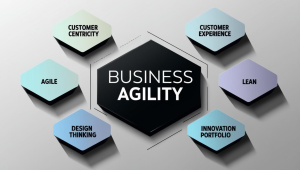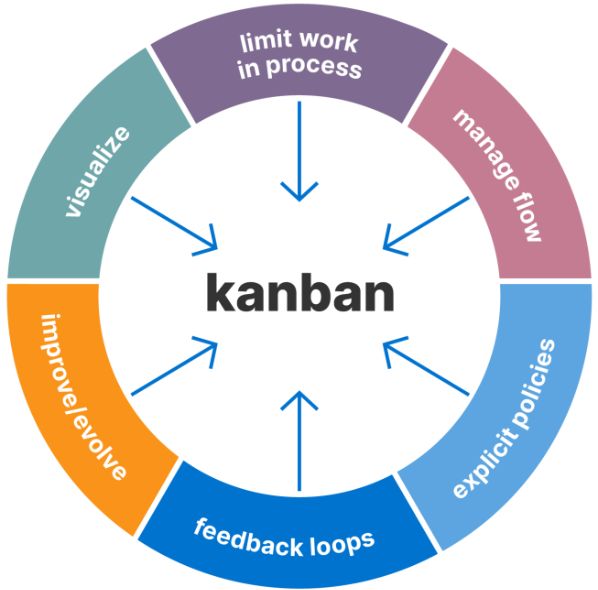
“But isn’t that the same thing?” – someone asked me the other day in a chat.
Good question. It’s normal to get confused, because “Business Agility” and “Agile” sound very similar. Anyone would think they are the same, or at least first cousins… But they are not. I would say they are more like those friends who look alike physically, but have very different personalities.
Today we are going to clarify once and for all this difference between Agile and Business Agility, and answer questions such as:
What are the real differences between Agile and Business Agility?
Is applying Scrum the same as being an agile company?
Why does my company say it is agile but we still approve everything by committee and with three signed copies?
Spoiler alert: you’re going to find out that this goes way beyond “making dailies”.
What is Agile really? More than post-its and sprints
Let’s start at the beginning. When we talk about Agile, we don’t just mean methodologies like Scrum or Kanban, but a mindset and a culture.
Agile was born in 2001 with the Agile Manifesto, where a group of technologists proposed more humane and effective ways of working. Since then, it has transformed the way many teams deliver value.
The 4 values of the Agile Manifesto:
Individuals and interactions on processes and tools
Software running on extensive documentation
Collaboration with the client on contract negotiation
Responding to change over following a plan
Agile is a way of thinking that promotes iterative delivery, collaboration, adaptation and continuous improvement.
For example, a team that uses Scrum and delivers features every two weeks, prioritizing what the customer needs now and not what was defined six months ago, is being agile.
However, Agile is usually applied at the level of specific teams or areas, mainly in IT or product development. It is a good starting point… but not enough.
What is Business Agility? The next level
This is where we move up in the league.
Business Agility is the ability of an entire organization to adapt, learn and pivot quickly in the face of market changes.
It’s not about having just one agile team, but about having all areas – yes, even legal, marketing or finance – working under agile principles.
In an organizational transformation process, Business Agility is that step in which the entire company begins to breathe agility.
Imagine this: you have an agile IT team. But to launch a feature, you have to wait three months for other departments to give the go-ahead. Result? The customer is gone. That’s not real agility.
The 6 dimensions of Business Agility
Customer Centricity – The customer really at the center.
Customer Experience – Memorable and consistent experiences.
Agile – Application of frameworks such as Scrum, Kanban or SAFe.
Lean – Eliminate everything that does not add value.
Design Thinking – Solving problems with empathy and creativity.
Innovation Portfolio – Managing innovation as part of the business.
An example: Michelin decided to manufacture tires that would last 4 times longer. Loss of sales? On the contrary. They were able to understand the customer and adapt the business. That is Business Agility.

An example I like to share is that of Michelin, who decided to make tires that would last 4 times longer. Loss of sales? On the contrary, they became market leaders because they understood the customer and adapted. That’s Business Agility in action.
Agile Methodologies Comparison: Agile vs Business Agility
Here is the promised summary table to answer the eternal business agility vs agile question:
| Aspect | Agile | Business Agility |
| Scope | Teams or projects | Entire organization |
| Origin | Software development | Business strategy |
| Main objective | Continuous delivery of value | Adaptation and global competitiveness |
| Common tools | Scrum, Kanban, SAFe | Lean, Design Thinking, OKRs, Agile |
| Culture | Collaboration and adaptability | Constant innovation and flexibility |
| Customers | Involved in the product | At the center of all decisions |
| Typical example | Development sprint | Pivot business model in weeks |
“Save this chart for when they ask you at the next meeting what the heck Business Agility is.”
As a firstquick conclusion we can say:
- Agile is how we work in teams.
- Business Agility is how the entire company thinks and acts.
Why is it important to understand this difference?

Because many organizations fall into the famous Agile washing: they start using words like sprint or backlog and think they are already agile.
But doing Scrum in IT while everything else is still running slow, hierarchical and bureaucratic processes… is not business agility.
It’s like buying sportswear and thinking you’re already in shape. Intention counts, but it’s not enough.
The most common pitfalls: when Agile falls short
Agile in silos: Agile teams hitting internal walls.
Rigid processes outside IT: Eternal approvals in other areas.
Fear of error: No room for failure, no innovation.
Lack of global vision: Each team goes its own way.
This is where Business Agility changes the rules of the game. It’s not just about being efficient, it’s about being resilient, adaptable and competitive.
How to move from Agile to Business Agility?

Good question, young padawan. There is no magic wand here, but there are some very concrete steps that we have applied in multiple organizational consulting processes.
Culture of continuous improvement
Hindsight is not just a Scrum thing. The entire organization should have the ability to constantly reflecting and adapting. If you don’t know where to start, remember this mantra:
“If you can only do one Agile event…make it a retrospective.”
Breaking organizational silos
Agility does not understand departmental boundaries. Facilitating cross-functional collaboration is key to scaling the impact of agile beyond the product team.
Putting the customer truly at the center
It’s not enough to say that the customer matters. You have to make decisions based on what really adds value, even if that means questioning internal processes.
Agile Leadership
You need leaders who empower rather than control. Who understand the phases of the team (hello Tuckman) and adapt with flexibility. In our Agile consulting, we work with leaders who want to truly accompany, not just supervise.
Managing innovation
Having an Innovation Portfolio allows you to maintain a balance between stability and exploration. It is not about having an “innovation” team, but about making innovation part of the culture.
Is Business Agility for all companies?
I would say yes, but with nuances. Business Agility is not a fad, it is a necessity in constantly changing environments. But it is not for everyone… at least not right away.
Requires:
Patience: This is not plug & play.
Change of mentality: Yes, also from management.
Change management: Because the urgent will always try to kill the important.
If your company wants to survive the present and lead the future, business agility is not optional.
Final thought: It’s not Agile vs. Business Agility… it’s Agile + Business Agility.
It’s not a choice between one or the other. Agile is the engine. Business Agility is the complete vehicle.
You can have the best engine in the world, but if your car doesn’t have wheels, you won’t get very far.
So the next time you hear about Business Agility vs Agile, remember:
Agile helps you work better
Business Agility helps you compete better
In a world where change is the only constant, wouldn’t you like your company not only to survive, but to lead?
If after reading this you’ve been thinking “ok, now how do I start?”, you know where to find us.


